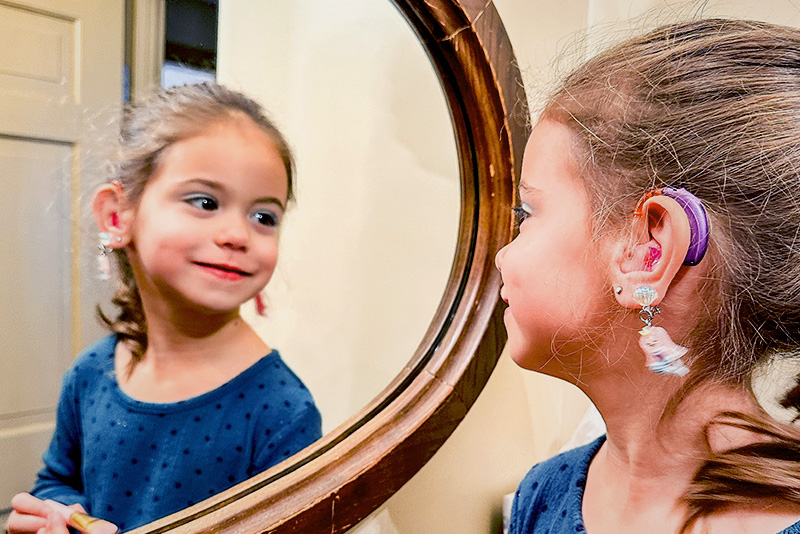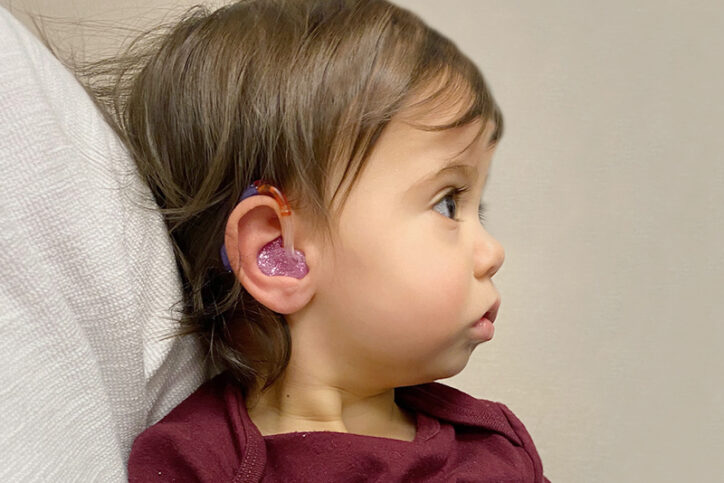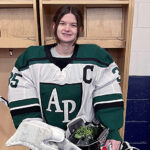‘Empowered to be there for Teagan’: New parents learn about hearing loss

Teagan O’Brien is a bright, spunky 4-year-old who loves reading, dancing, and playing outdoors. Her parents, Kim and Donnie, are firefighters who throw themselves into any new situation. Since they adopted Teagan three-and-a-half years ago, they’ve thrown themselves into supporting her with help from her team at Boston Children’s Hospital.
Teagan was already a patient of Boston Children’s Cleft Lip and Craniofacial Center in March 2020 when Kim and Donnie first brought her home. Four months earlier, she’d been born with a cleft palate, an opening in the roof of the mouth. It would take some time before her new parents could confirm that she also had hearing loss.
Pandemic complicates hearing loss diagnosis
Not long after Teagan became part of their family, Kim and Donnie started to suspect she had trouble hearing. “If we weren’t right in front of her, she wouldn’t react to us,” says Donnie.
Teagan’s plastic surgeon, Dr. John Meara, recommended genetic testing. Typically, knowing if there’s a family history of hearing loss helps determine the cause and options for treatment. But Kim and Donnie didn’t have access to such information.

By then, the COVID-19 pandemic was sweeping the country, forcing hospitals in Massachusetts to postpone any “non-essential” in-person visits. During a virtual visit with the Division of Genetics and Genomics, Kim and Donnie learned that Teagan had a chromosome deletion related to hearing loss. In a follow-up visit (also virtual) with the Department of Otolaryngology, they learned how options like American Sign Language (ASL) and speech therapy can help toddlers with hearing loss develop early communication skills.
“The education we received from Boston Children’s empowered us to be there for Teagan,” says Kim. Soon, all three of the O’Briens were enrolled in ASL classes. As their ASL vocabularies grew, their ability to communicate increased.
Adapting to hearing aids
October 2020 was a big month for Teagan. Dr. Meara closed the gap in her palate and audiologist Dr. Heather Rauch confirmed that she had hearing loss. Two months later, when Teagan was 1, she got hearing aids.
The first time she put her hearing aids on, she didn’t seem to know what to make of the signals coming in through her ears. Yet with increased access to sound, she was able to start speech therapy and develop spoken language skills. Today, she switches back and forth between speech and ASL, signing a word when she can’t think of how to say it.

Her parents, who consider their daughter a rockstar, say she’s worn the hearing aids consistently from day one. If she needs a break, in a loud restaurant for instance, she’ll ask her parents if she can take them out, “and then we rely on sign,” says Donnie. With obvious pride, he adds, “She recently got up in front of her preschool class and told them about her hearing loss and how her hearing aids work.”
Team Teagan
Teagan’s team at Boston Children’s continues to grow. After a local dentist recommended dental surgery, Kim and Donnie contacted Dr. Meara. “He reassured us that no, she didn’t need surgery,” says Kim. Now Teagan receives dental care through Boston Children’s Department of Dentistry.
“We do as much as we can through Boston Children’s,” says Kim. “The whole system is so streamlined — the doctors talk to each other. That really helps.”

Kim and Donnie are well known in their community, and other parents whose children have hearing loss often approach them for advice. They always recommend giving children as many options as possible, options they learned about through Boston Children’s and by immersing themselves in Deaf culture. “We believe Teagan should get to choose what she wants to do,” says Kim. “We’ve just tried to empower her to do that.”
In the future, if Teagan’s hearing loss progresses, one option may be cochlear implants.
In typical fashion, Kim and Donnie want Teagan to play a leading role in making that decision. “We’re going to cross that bridge if we get there,” says Kim. “And it may sound funny, because she’s only 4, but it’s her life. She’ll be allowed to make the decision about whether or not to get implants.”
Learn more about the Deaf and Hard of Hearing Program and the Cleft Lip and Craniofacial Center.
Related Posts :
-

How hearing aids opened up a world of sound for Harry
Maybe it’s unusual to bring a musical instrument to an audiology appointment, but that didn’t stop Harry King. ...
-

Learning to speak with the help of a bone-anchored hearing system: Owen’s story
Why does 4-year-old Owen love Ghost Spider? For one thing, her suit has purple highlights. For another, her hand forms ...
-

How I hear you: Isabelle’s cochlear implant story
Isabelle is a thriving AP student, hockey player, and online gamer who listens to music and communicates with the help ...
-

A different kind of hearing: Caleb’s cochlear implant
Caleb recently told his mother, “I think I’m going to write my own stories.” This news didn’t surprise ...





